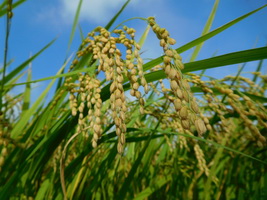
Scientists Shed Light on the Role of Abscisic Acid in Rice Disease Resistance
March 21, 2018| |
 Lesion mimic mutants exhibit spontaneous cell death, thus, can be studied to understand the mechanism of cell death and disease-resistance. Although these mutants have been characterized in rice, the relationship between lesion formation and abscisic acid (ABA) is quite unknown. A team led by Liao Yongxiang from Sichuan Agricultural University in China identified a rice mutant, named lesion mimic mutant9150 (lmm9150). The mutant exhibits spontaneous cell death, enhanced growth, and resistance to rice bacterial and blast diseases.
Lesion mimic mutants exhibit spontaneous cell death, thus, can be studied to understand the mechanism of cell death and disease-resistance. Although these mutants have been characterized in rice, the relationship between lesion formation and abscisic acid (ABA) is quite unknown. A team led by Liao Yongxiang from Sichuan Agricultural University in China identified a rice mutant, named lesion mimic mutant9150 (lmm9150). The mutant exhibits spontaneous cell death, enhanced growth, and resistance to rice bacterial and blast diseases.
Researchers found that cell death in the mutant was accompanied with excessive accumulation of hydrogen peroxide. Enhanced disease-resistance and upregulation of defense-related genes were also found to be associated with cell death. ABA levels in the lmm9150 mutant were also significantly reduced. Further analysis revealed a point mutation in the OsABA2 gene, a vital gene for ABA synthesis, in the lmm9150 mutants.
Through CRISPR-Cas9 knockout of OsABA2, the researchers generated gene-edited lines with similar phenotypes to lmm9150, proving that OsABA2 was truly responsible for the lmm9150 mutant.
This data revealed the connection of ABA deficiency to cell death and provided insights into the role of ABA in rice disease-resistance.
For more information, read the article in Frontiers in Plant Science.
| |
Biotech Updates is a weekly newsletter of ISAAA, a not-for-profit organization. It is distributed for free to over 22,000 subscribers worldwide to inform them about the key developments in biosciences, especially in biotechnology. Your support will help us in our mission to feed the world with knowledge. You can help by donating as little as $10.
-
See more articles:
-
News from Around the World
- Crops Hold Rare Harmful Mutations that Reduce Productivity
- NY Student Wins Award on Solution for Potato Late Blight
- Golden Rice Gets Approval from Health Canada
- Mexican Researchers Develop GE Tomato that Decreases Hypertension
- Australian OGTR Releases Notifications of License Application for 2 GM Crops; Invites Comments on Commercial Release of GM Safflower
- Plants Found to Overcome Hunger by Activating Autophagy
- Expert Says New Breeding Technologies Can Help Grow More Food
- Report: Gains in Corn Production in the Philippines Largely Due to GE Seeds
- English Journalist Reviews Mark Lynas' Book, Seeds of Science
- Scientists Discover Gene that Confers Flood Tolerance, Drought Tolerance, and Disease Resistance in Rice
-
Research Highlights
- Sheepgrass MADS-Box Genes Involved in Abiotic Stress Responses
- Researchers Find Genes Conferring Enhanced Defense against Cassava Bacterial Blight
-
Resources
- Pocket K No. 56: Substantial Equivalence of GM and Non-GM Crops
- Book: How to Feed the World
-
Plant
- Chinese Researchers Pinpoint Maize Gene for Male Sterility
- BrAP2 Gene Holds Key to Improved Seed Production in Brassica
- CRISPR-Cas9 System Applicable in Cultivated Strawberry
- Scientists Shed Light on the Role of Abscisic Acid in Rice Disease Resistance
-
Read the latest: - Biotech Updates (December 17, 2025)
- Gene Editing Supplement (December 17, 2025)
- Gene Drive Supplement (February 22, 2023)
-
Subscribe to BU: - Share
- Tweet
